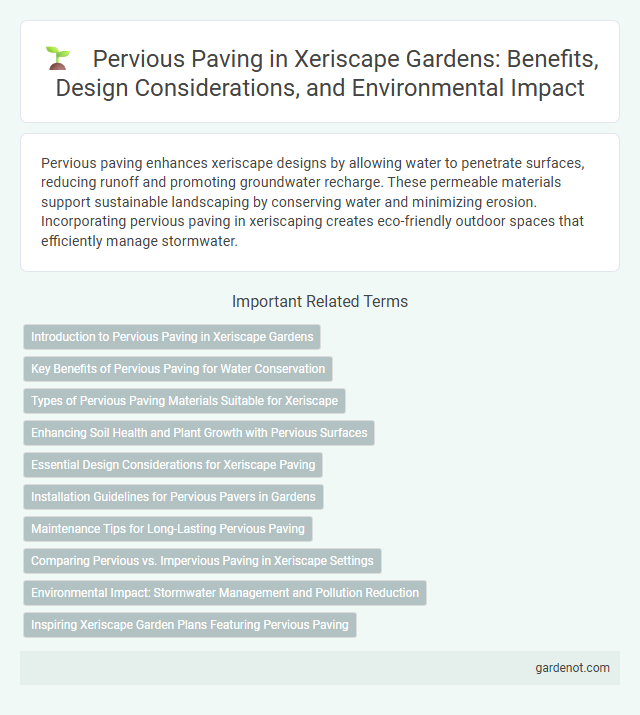Pervious paving enhances xeriscape designs by allowing water to penetrate surfaces, reducing runoff and promoting groundwater recharge. These permeable materials support sustainable landscaping by conserving water and minimizing erosion. Incorporating pervious paving in xeriscaping creates eco-friendly outdoor spaces that efficiently manage stormwater.
Introduction to Pervious Paving in Xeriscape Gardens
Pervious paving materials allow water to infiltrate through surfaces, reducing runoff and promoting groundwater recharge in xeriscape gardens. Common types include porous concrete, permeable pavers, and gravel, which enhance water efficiency in drought-prone landscapes. Integrating pervious paving supports sustainable water management by maintaining soil moisture and reducing the need for supplemental irrigation.
Key Benefits of Pervious Paving for Water Conservation
Pervious paving significantly enhances water conservation by allowing rainwater to infiltrate the ground, reducing runoff and promoting groundwater recharge. This sustainable solution mitigates flooding risks and filters pollutants, improving overall water quality in urban environments. Its porous structure helps maintain natural hydrological cycles while supporting xeriscape principles through efficient water management.
Types of Pervious Paving Materials Suitable for Xeriscape
Pervious paving materials suitable for xeriscape include porous concrete, pervious asphalt, and interlocking concrete pavers, each allowing water infiltration to reduce runoff and promote groundwater recharge. Gravel and decomposed granite also serve as effective permeable surfaces, enhancing soil moisture retention while minimizing erosion. These materials support sustainable landscaping by conserving water and maintaining healthy soil ecosystems in drought-prone areas.
Enhancing Soil Health and Plant Growth with Pervious Surfaces
Pervious paving significantly enhances soil health by allowing water to infiltrate the ground, reducing runoff and promoting natural groundwater recharge. This increased soil moisture supports root development and plant growth, creating healthier xeriscape landscapes. The use of pervious surfaces also helps maintain soil microbial activity, essential for nutrient cycling and plant vitality.
Essential Design Considerations for Xeriscape Paving
Pervious paving in xeriscape design enhances water infiltration and reduces runoff, essential for sustainable landscape management. Selecting materials with high porosity like permeable concrete, porous asphalt, or interlocking pavers supports efficient stormwater absorption and minimizes soil erosion. Proper base layer preparation and grading ensure structural integrity and optimal drainage, promoting water conservation in arid environments.
Installation Guidelines for Pervious Pavers in Gardens
Proper installation of pervious pavers in gardens begins with site assessment, ensuring adequate soil infiltration rates and slope for water drainage. A base layer of crushed stone is essential to promote water permeability and stability, followed by precise placement of pavers with uniform spacing to allow water passage. Regular maintenance, including cleaning joints and inspecting for sediment buildup, ensures long-term effectiveness of pervious paving in sustainable garden design.
Maintenance Tips for Long-Lasting Pervious Paving
To ensure long-lasting pervious paving in xeriscape designs, regularly remove debris and sediment that can clog the pores and reduce permeability. Schedule periodic vacuuming or pressure washing to maintain optimal water infiltration and prevent surface damage. Inspect joints and replace damaged sections promptly to uphold structural integrity and prolong the lifespan of the paving system.
Comparing Pervious vs. Impervious Paving in Xeriscape Settings
Pervious paving in xeriscape settings enhances water infiltration, reducing runoff and promoting groundwater recharge compared to impervious surfaces that contribute to increased flooding and erosion. This sustainable paving option supports drought-resistant landscaping by allowing rainwater to reach plant roots directly, improving soil moisture and reducing irrigation needs. Impervious paving materials, such as concrete and asphalt, often disrupt natural hydrological cycles, making pervious paving a critical element in efficient water management for xeriscapes.
Environmental Impact: Stormwater Management and Pollution Reduction
Pervious paving significantly enhances stormwater management by allowing rainwater to infiltrate the ground, reducing surface runoff and minimizing the risk of flooding. This environmentally friendly design filters pollutants such as oils, heavy metals, and sediment before they reach waterways, improving water quality. Incorporating pervious surfaces in xeriscaping contributes to sustainable landscapes by conserving water and supporting natural hydrological cycles.
Inspiring Xeriscape Garden Plans Featuring Pervious Paving
Pervious paving enhances xeriscape garden plans by allowing water to infiltrate the soil, reducing runoff and promoting efficient water use. Integrating materials such as permeable concrete, porous asphalt, or interlocking pavers supports sustainable landscaping that conserves water and maintains healthy plants. These innovative surfaces complement drought-tolerant plant selections and create functional, eco-friendly outdoor spaces optimized for arid climates.
Pervious paving Infographic

 gardenot.com
gardenot.com